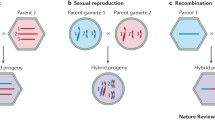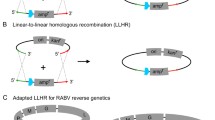Abstract
The matrix protein (M) is one of only five genes in the RV genome and is an important multifunctional protein. Besides to allow for the release of newly replicated virions pairing with G, the M protein also functions in virus replication, pathogenicity, and host cell apoptosis. The goal of present study is to generate recombinant viruses with M gene rearranged, thus laying the foundation for further exploring what will happen when the gene for M is relocated on the RV single-strand RNA. We used rHEP-Flury, an attenuated virus that remains virulent for less than 3 days in sucking mice, to reshuffle the M gene, using an approach that leaves the other viral nucleotide sequence intact. Two viruses with translocated M genes (N1M2 and N1M4) were recovered from each of the rearranged cDNAs, whose gene order is 3′-N-M-P-G-L-5′ and 3′-N-P-G-M-L-5′ respectively. The growth dynamics of these viruses showed slower replication than the wild-type virus in multiple-step growth curves, but they can grow to a comparable titer in tests of single-step growth curves. Further experimentation with these rearranged viruses will provide insights into the relationships between genome structure and virus phenotypes.




Similar content being viewed by others
References
Abraham G, Banerjee AK. The nature of the RNA products synthesized in vitro by subviral components of vesicular stomatitis virus. Virology. 1976;71:230–41.
Albertini AAV, Schoehn G, Weissenhorn W, Ruigrok RWH. Structural aspects of rabies virus replication. Cell Mol Life Sci. 2008;65:282–94.
Albertini AAV, Wernimont AK, Muziol T, Ravelli RBG, Clapier CR, Schoehn G, Weissenhorn W, Ruigrok RWH. Crystal structure of the rabies virus nucleoprotein-RNA complex. Science. 2006;313:360–3.
Ball LA, Pringle CR, Flanagan B, Perepelitsa VP, Wertz GW. Phenotypic consequences of rearranging the P, M, and G genes of vesicular stomatitis virus. J Virol. 1999;73:4705–12.
Barr N, Whelan SP, Wertz GW. Role of the intergenic dinucleotide in vesicular stomatitis virus RNA transcription. J Virol. 1997;71:1794–801.
Buchholz UJ, Finke S, Conzelmann KK. Generation of bovine respiratory syncytial virus (BRSV) from cDNA: BRSV NS2 is not essential for virus replication in vitro and the human RSV leader region acts as a functional BRSV genome promoter. J Virol. 1999;73:251–9.
Conzelmann KK. Nonsegmented negative-strand RNA viruses: genetics and manipulation of viral genomes. Annu Rev Genet. 1998;32:123–62.
Delmas O, Holmes EC, Talbi C, Larrous F, Dacheux L, Bouchier C, Bourhy H. Genomic diversity and evolution of the lyssaviruses. PLoS One. 2008;3:e2057.
Faber M, Faber ML, Papaneri A, Bette M, Weihe E, Dietzschold B, Schnell MJ. A single amino acid change in rabies virus glycoprotein increases virus spread and enhances virus pathogenicity. J Virol. 2005;79:14141–8.
Faber M, Pulmanausahakul R, Hodawadekar SS, Spitsin S, McGettigan JP, Schnell MJ, Dietzschold B. Overexpression of the rabies virus glycoprotein results in enhancement of apoptosis and antiviral immune response. J Virol. 2002;76:3374–81.
Finke S, Conzelmann KK. Dissociation of rabies virus matrix protein functions in regulation of viral RNA synthesis and virus assembly. J Virol. 2003;77:12074–82.
Finke S, Cox JH, Conzelmann KK. Differential transcription attenuation of rabies virus genes by intergenic regions: generation of recombinant viruses overexpressing the polymerase gene. J Virol. 2000;74:7261–9.
Finke S, Mueller-Waldeck R, Conzelmann KK. Rabies virus matrix protein regulates the balance of virus transcription and replication. J Gen Virol. 2003;84:1613–21.
Flanagan EB, Ball LA, Wertz GW. Moving the glycoprotein gene of vesicular stomatitis virus to promoter-proximal positions accelerates and enhances the protective immune response. J Virol. 2000;74:7895–902.
Flanagan EB, Zamparo JM, Ball LA, Rodriguez LL, Wertz GW. Rearrangement of the genes of vesicular stomatitis virus eliminates clinical disease in the natural host: new strategy for vaccine development. J Virol. 2001;75:6107–14.
Ghanem A, Kern A, Conzelmann KK. Significantly improved rescue of rabies virus from cDNA plasmids. Eur J Cell Biol. 2011;91:10–6.
Inoue K, Shoji Y, Kurane I, Iijima T, Sakai T, Morimoto K. An improved method for recovering rabies virus from cloned cDNA. J Virol Methods. 2003;107:229–36.
Ito N, Takayama-Ito M, Yamada K, Hosokawa J, Sugiyama M, Minamoto N. Improved recovery of rabies virus from cloned cDNA using a vaccinia virus-free reverse genetic system. Microbiol Immunol. 2003;47:613–7.
Ito N, Takayama M, Yamada K, Sugiyama M, Minamoto N. Rescue of rabies virus from cloned cDNA and identification of the pathogenicity-related gene: glycoprotein gene is associated with virulence for adult mice. J Virol. 2001;75:9121–8.
Iverson LE, Rose JK. Localized attenuation and discontinuous synthesis during vesicular stomatitis virus transcription. Cell. 1981;23:477–84.
Kassis R, Larrous F, Estaquier J, Bourhy H. Lyssavirus matrix protein induces apoptosis by a TRAIL-dependent mechanism involving caspase-8 activation. J Virol. 2004;78:6543–55.
Knobel DL, Cleaveland S, Coleman PG, Fèvre EM, Meltzer MI, Miranda MEG, Shaw A, Zinsstag J, Meslin FX. Re-evaluating the burden of rabies in Africa and Asia. Bull World Health Organ. 2005;83:360–8.
Komarova AV, Real E, Borman AM, Brocard M, England P, Tordo N, Hershey JWB, Kean KM, Jacob Y. Rabies virus matrix protein interplay with eIF3, new insights into rabies virus pathogenesis. Nucleic Acids Res. 2007;35:1522–32.
Mebstsion T, Weiland F, Conzelmann KK. Matrix protein of rabies virus is responsible for the assembly and budding of bullet-shaped particles and interacts with the transmembrane spike glycoprotein G. J Virol. 1999;73:242–50.
Pulmanausahakul R, Li J, Schnell MJ, Dietzschold B. The glycoprotein and the matrix protein of rabies virus affect pathogenicity by regulating viral replication and facilitating cell-to-cell spread. J Virol. 2007;82:2330–8.
Schnell MJ, Mebatsion T. Conzelmann1 KK. Infectious rabies viruses from cloned cDNA. EMBO J. 1994;13:4195–203.
Shimizu K, Ito N, Mita T, Yamada K, Hosokawa-Muto J, Sugiyama M, Minamoto N. Involvement of nucleoprotein, phosphoprotein, and matrix protein genes of rabies virus in virulence for adult mice. Virus Res. 2007;123:154–60.
Takayama-Ito M, Inoue K, Shoji Y, Inoue S, Iijima T, Sakai T, Kurane I, Morimoto K. A highly attenuated rabies virus HEP-Flury strain reverts to virulent by single amino acid substitution to arginine at position 333 in glycoprotein. Virus Res. 2006;119:208–15.
Tordo N, Poch O, Ermine A, Keitht G, Rougeon F. Walking along the rabies genome: is the large G-L intergenic region a remnant gene. Proc Natl Acad Sci. 1986;83:3914–8.
Wertz GW, Perepelitsa VP, Ball LA. Gene rearrangement attenuates expression and lethality of a nonsegmented negative strand RNA virus. Proc Natl Acad Sci. 1998;95:3501–6.
Wirblich C, Schnell MJ. Rabies virus (RV) glycoprotein expression levels are not critical for pathogenicity of RV. J Virol. 2011;85:697–704.
Wu X, Rupprecht CE. Glycoprotein gene relocation in rabies virus. Virus Res. 2008;131:95–9.
Yan Y, Samal SK. Role of intergenic sequences in newcastle disease virus RNA transcription and pathogenesis. J Virol. 2007;82:1323–31.
Zhao L, Toriumi H, Kuang Y, Chen H, Fu ZF. The roles of chemokines in rabies virus infection: overexpression may not always be beneficial. J Virol. 2009;83:11808–18.
Zhang G, Wang H, Mahmood F, Fu ZF. Rabies virus glycoprotein is an important determinant for the induction of innate immune responses and the pathogenic mechanisms. Vet Microbiol. 2013;162:601–13.
Acknowledgements
This study was partially supported by a grant From the National Natural Science Foundation of China (Nos. 31172322) and Special Fund for Agro-scientific Research in the Public Interest (Nos. 201103032); The project of General Administration of Quality Supervision, Inspection and Quarantine of the People’s Republic of China (Nos. 2012IK005).
Author information
Authors and Affiliations
Corresponding author
Electronic supplementary material
Below is the link to the electronic supplementary material.
Rights and permissions
About this article
Cite this article
Yang, XF., Peng, JJ., Liang, HR. et al. Gene order rearrangement of the M gene in the rabies virus leads to slower replication. VirusDis. 25, 365–371 (2014). https://doi.org/10.1007/s13337-014-0220-1
Received:
Accepted:
Published:
Issue Date:
DOI: https://doi.org/10.1007/s13337-014-0220-1




